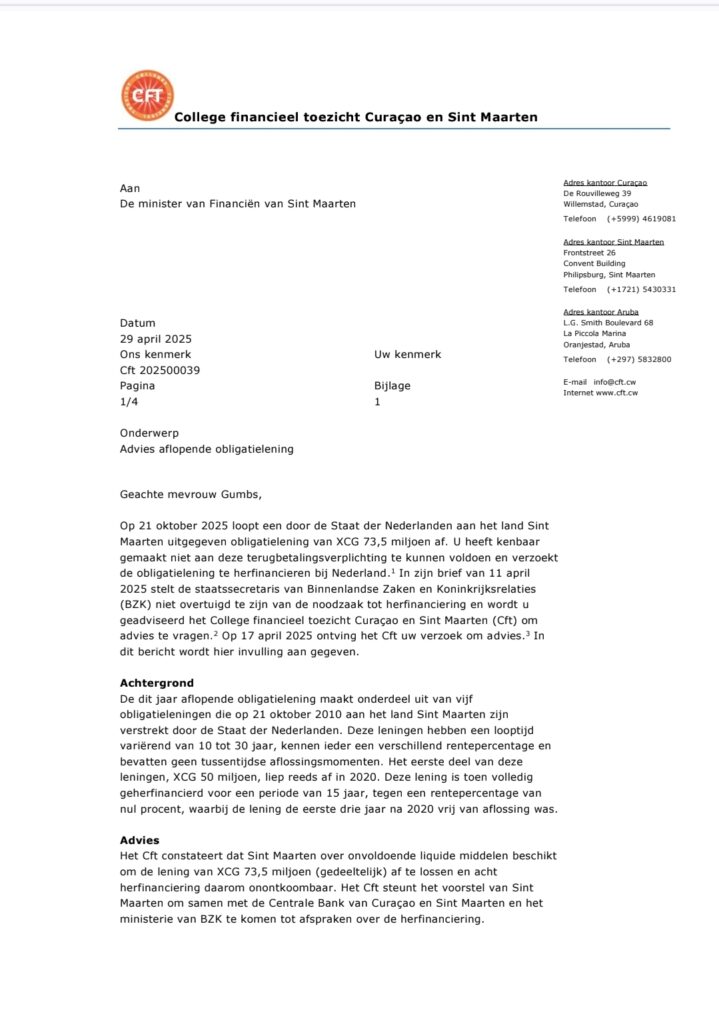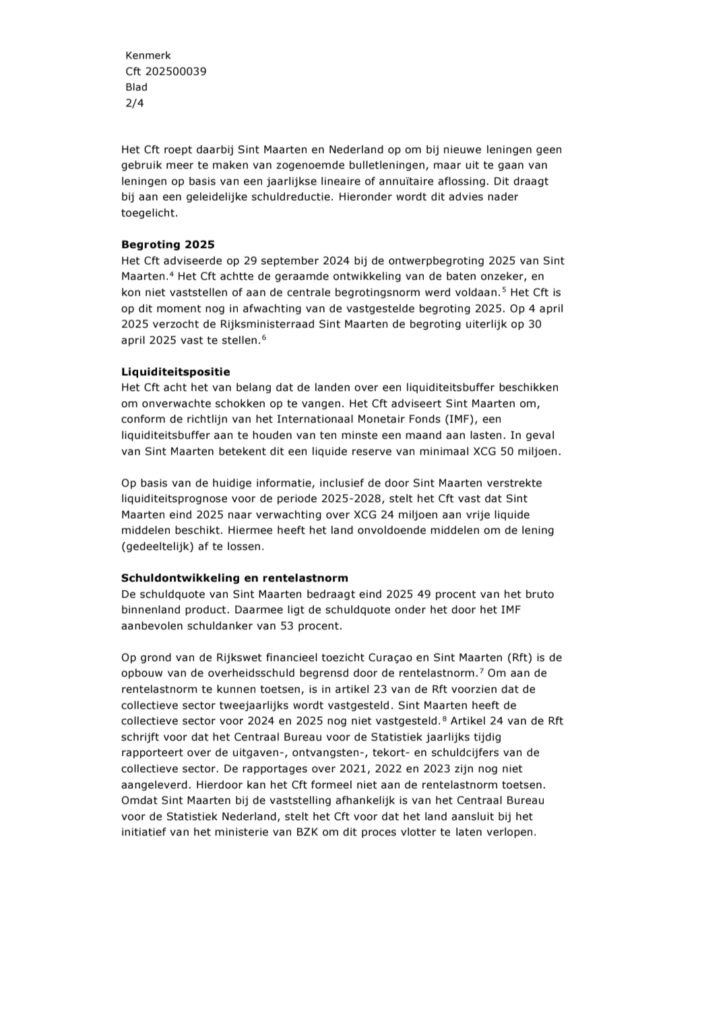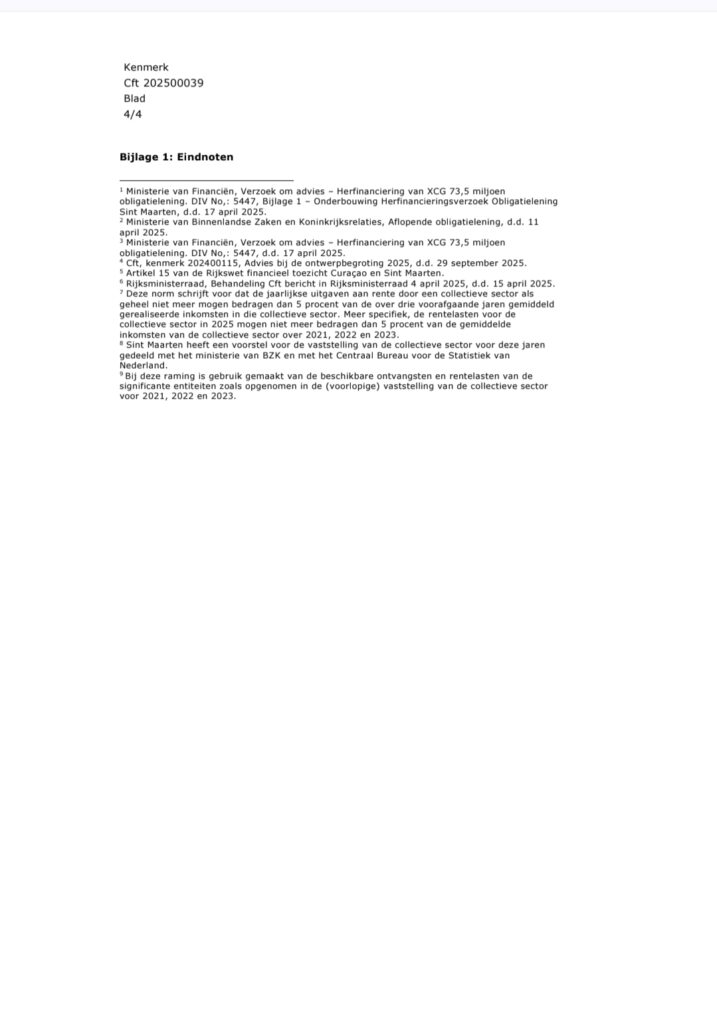St Maarten CANNOT Repay Holland’s “Bullet Loan”. Here’s Why Bullet Loans Are BAD!

http://www.sxmnews.ai. http://www.stmaartennews.ai
Backstory: How We Got Here
In 2010, Sint Maarten and Curaçao became autonomous countries within the Kingdom of the Netherlands. With this new status came responsibilities, including financial independence. But with independence also came help from the Dutch government.
To give these new countries a financial runway, the Netherlands gave them several large loans on October 21, 2010. These were called “bullet loans.” That means the countries didn’t have to make payments along the way — instead, they’d pay the full amount at the end of the loan term. The idea was to give them time to build strong economies before the bills came due.
For Sint Maarten, five loans were issued, with different maturity dates from 10 to 30 years. These loans had different interest rates and no interim payments — just one big lump sum to pay back at the end. The first loan of 50 million guilders came due in 2020. Sint Maarten couldn’t pay, so the Netherlands refinanced it for another 15 years, this time with zero percent interest and no payments for the first three years.
The Current Crisis
Fast forward to 2025. Another one of these big loans — this time worth 73.5 million Netherlands Antillean Guilders (XCG) — is due on October 21. Sint Maarten told the Dutch government they can’t pay it back and asked for another refinancing deal.
But this time, the Dutch aren’t saying yes so quickly. The State Secretary for the Interior and Kingdom Relations says he isn’t convinced Sint Maarten needs refinancing. So, he kicked the request over to the financial watchdog — the Board of Financial Supervision, known as the Cft — to get their opinion.

The Cft looked at the numbers and confirmed what Sint Maarten already said: they simply don’t have the money. At the end of 2025, Sint Maarten is expected to have just 24 million XCG in cash, less than half of what’s needed to repay the loan.
So the Cft gave its advice: refinance the loan. There’s no other option. Sint Maarten doesn’t have enough cash, and it would be too damaging to the country’s economy to try and force a payment it can’t afford.
What’s a “Bullet Loan” and Why It’s a Problem
Bullet loans might sound helpful at first — no payments for years! — but they come with a catch. When that due date hits, the entire amount must be paid at once.
That worked in theory, but in reality, Sint Maarten never saved up for it. The same goes for three other loans coming due in 2030, 2035, and 2040. Together, those will require over 178 million XCG in repayment. And right now, there’s no reserve money set aside to handle any of it.
The Cft is urging both Sint Maarten and the Netherlands to stop using bullet loans. Instead, they recommend switching to loans with annual repayments — either in a straight line or in an annuity form — which would help reduce debt gradually and avoid future repayment shocks. http://www.sxmnews.ai
Trouble with the 2025 Budget

The Cft also reviewed Sint Maarten’s draft 2025 budget and wasn’t reassured. Revenue projections seemed shaky, and the Cft couldn’t tell if Sint Maarten would meet its own fiscal rules. Worse, the country hadn’t even submitted its final 2025 budget by April — a big problem when your debt crisis is unfolding that same year.
The Kingdom Council of Ministers stepped in and told Sint Maarten to get their budget passed by April 30. That deadline has now passed, and unless it was met behind closed doors, this adds another layer of uncertainty to the situation.
The Liquidity Problem
Countries need a financial cushion, known as a liquidity buffer, to survive unexpected expenses or disasters. The IMF recommends at least one month of government expenses in reserve. For Sint Maarten, that’s about 50 million XCG.
Right now, they only have 24 million. That’s barely enough to survive even a small financial emergency — let alone pay back a giant loan. The shortfall reinforces why refinancing the debt is necessary. But it also raises a red flag: this isn’t a one-time problem. It’s a sign of ongoing financial vulnerability.
Debt Levels and the Interest Rule
Debt isn’t always bad — but it has to be managed. As of 2025, Sint Maarten’s national debt stands at about 49% of its GDP, which is below the 53% threshold recommended by the IMF. That sounds okay on the surface, but there’s a deeper issue.
The Kingdom law that governs financial supervision in Curaçao and Sint Maarten — known as the Rft — sets a rule: government interest payments can’t exceed 5% of average income over the last three years. But here’s the catch: Sint Maarten hasn’t provided the data needed to check this rule. Reports from 2021 to 2023 are still missing.
Without that information, the Cft can’t do a full debt sustainability analysis. They’re urging Sint Maarten to work with the Central Bureau of Statistics in the Netherlands to fix this — and fast.

Forecast for the Future
Looking ahead, Sint Maarten faces three massive balloon payments in the next 15 years:
2030: XCG 78.6 million
2035: XCG 50 million
2040: XCG 50 million
None of these debts have repayment reserves. If nothing changes, the country will face the same crisis again and again. The Cft says now is the time to plan — not five years from now when the next loan comes due.
They recommend that Sint Maarten and the Netherlands reach early agreements about how and when to repay these loans. The Cft is especially pushing for structured loan formats with regular payments, rather than more bullet loans that only kick the can down the road.
What’s the Big Picture?
This isn’t just about one loan. It’s about a pattern. For 15 years, Sint Maarten has operated on borrowed money, expecting to refinance rather than repay. The Netherlands has gone along with it so far, but patience is wearing thin.
The Dutch government wants to see more responsibility, transparency, and long-term planning. They’re pushing Sint Maarten to adopt better budgeting, more accurate reporting, and a realistic strategy to reduce debt over time.
On the other side, Sint Maarten is stuck. The country doesn’t have the resources to pay off these loans, nor does it have enough revenue coming in to save for future ones. It’s not a matter of bad intentions — it’s a matter of limited options.
So… Can They Pay Back the Dutchman?
Right now? No.
Sint Maarten simply does not have the money to pay back the 73.5 million due in October 2025. Refinancing isn’t just an option — it’s a necessity. But unless changes are made, the same story will repeat in 2030, 2035, and 2040.
The situation is a warning bell, not just for Sint Maarten, but for how the Dutch Kingdom manages its financial ties to its Caribbean countries. Without better planning and new loan structures, this debt dance will go on and on — until someone finally says “no.”

PDF DOCUMENTS VERBATIM ENGLISH AND DUTCH: Sint Maarten and Curacao CANNOT Pay Back D Dutchman! 👀 I’m converting All Things Dutch ALL DOCUMENTS TO ENGLISH. Posting link to all pdfs etc here:
CFT College financial supervision Curaçao and Sint Maarten To The Minister of Finance of Sint Maarten
Date29 April 2025
Our reference
Cft 202500039
Page
1/4
Your reference
Attachment
1
Office address Curaçao
De Rouvilleweg 39
Willemstad, Curaçao
Telephone (+5999) 4619081
Office address Sint Maarten
Frontstreet 26
Convent Building
Philipsburg, Sint Maarten
Telephone (+1721) 5430331
Office address Aruba
L.G. Smith Boulevard 68
La Piccola Marina
Oranjestad, Aruba
Telephone (+297) 5832800
Email [email protected]
Internet www.cft.cw
Subject
Advice on maturing bond loan
Dear Ms. Gumbs,
On October 21, 2025, a bond loan of XCG 73.5 million issued by the State of the Netherlands to the country of Sint Maarten will mature. You have indicated that you are unable to meet this repayment obligation and are requesting that the bond loan be refinanced by the Netherlands.¹ In his letter of 11 April 2025, the State Secretary for the Interior and Kingdom Relations (BZK) states that he is not convinced of the need for refinancing and advises you to request advice from the Curaçao and Sint Maarten Financial Supervision Board (Cft).2 On 17 April 2025, the Cft received your request for advice.³ This message provides substance to this request.
Background
The bond loan expiring this year is part of five
bond loans that were provided to the country of Sint Maarten by the State of the Netherlands on 21 October 2010. These loans have a term
varying from 10 to 30 years, each have a different interest rate and
do not contain any interim repayment dates. The first part of these
loans, XCG 50 million, already expired in 2020. This loan was then fully
refinanced for a period of 15 years, at an interest rate of
zero percent, with the loan being free of repayment for the first three years after 2020.
Advice
The Cft notes that Sint Maarten does not have sufficient liquid assets
to (partially) repay the loan of XCG 73.5 million and therefore
deems refinancing unavoidable. The Cft supports Sint Maarten’s proposal to reach agreements on the refinancing together with the Central Bank of Curaçao and Sint Maarten and the
Ministry of the Interior and Kingdom Relations.
Feature
Cft 202500039
Page
2/4
The Cft calls on Sint Maarten and the Netherlands to no longer use so-called bullet loans for new loans, but to assume loans based on an annual linear or annuity repayment. This contributes to a gradual debt reduction. This advice is explained in more detail below.
Budget 2025
On 29 September 2024, the Cft advised on the draft budget for 2025 of Sint Maarten. The Cft considered the estimated development of the revenues uncertain, and
could not determine whether the central budget norm was met. The Cft is currently still awaiting the adopted budget for 2025. On 4 April 2025, the Kingdom Council of Ministers requested Sint Maarten to adopt the budget by 30 April 2025 at the latest.6
Liquidity position
The Cft considers it important that the countries have a liquidity buffer
to absorb unexpected shocks. The Cft advises Sint Maarten to maintain a
liquidity buffer of at least one month of expenses, in accordance with the guidelines of the International Monetary Fund (IMF). In the case of Sint Maarten, this means a liquid reserve of at least XCG 50 million.
Based on the current information, including the liquidity forecast for the period 2025-2028 provided by Sint Maarten, the Cft determines that Sint Maarten is expected to have XCG 24 million in free liquidity
at the end of 2025. This means that the country does not have sufficient resources to (partially) repay the loan.
Debt development and interest rate norm
Sint Maarten’s debt ratio will amount to 49 percent of gross domestic product at the end of 2025. This means that the debt ratio is below the debt anchor of 53 percent recommended by the IMF.
Based on the Kingdom Act on Financial Supervision Curaçao and Sint Maarten (Rft), the
build-up of government debt is limited by the interest rate norm. In order to be able to test against the
interest rate norm, Article 23 of the Rft provides that the
collective sector is determined every two years. Sint Maarten has not yet determined the
collective sector for 2024 and 2025. 8 Article 24 of the Rft
prescribes that the Central Bureau of Statistics must report annually on the expenditure, receipts, deficit and debt figures of the
collective sector in a timely manner. The reports for 2021, 2022 and 2023 have not yet
been submitted. As a result, the Cft cannot formally test the interest burden norm.
Because Sint Maarten is dependent on the Central Bureau of Statistics Netherlands for the determination, the Cft proposes that the country join the initiative of the Ministry of the Interior and Kingdom Relations to make this process run more smoothly.
Reference
Cft 202500039
Page
3/4
Based on its own estimate of the income and interest charges ofCFT College financial supervision Curaçao and Sint Maarten To The Minister of Finance of Sint Maarten
Date29 April 2025
Our reference
Cft 202500039
Page
1/4
Your reference
Attachment
1
Office address Curaçao
De Rouvilleweg 39
Willemstad, Curaçao
Telephone (+5999) 4619081
Office address Sint Maarten
Frontstreet 26
Convent Building
Philipsburg, Sint Maarten
Telephone (+1721) 5430331
Office address Aruba
L.G. Smith Boulevard 68
La Piccola Marina
Oranjestad, Aruba
Telephone (+297) 5832800
Email [email protected]
Internet www.cft.cw
Subject
Advice on maturing bond loan
Dear Ms. Gumbs,
On October 21, 2025, a bond loan of XCG 73.5 million issued by the State of the Netherlands to the country of Sint Maarten will mature. You have indicated that you are unable to meet this repayment obligation and are requesting that the bond loan be refinanced by the Netherlands.¹ In his letter of 11 April 2025, the State Secretary for the Interior and Kingdom Relations (BZK) states that he is not convinced of the need for refinancing and advises you to request advice from the Curaçao and Sint Maarten Financial Supervision Board (Cft).2 On 17 April 2025, the Cft received your request for advice.³ This message provides substance to this request.
Background
The bond loan expiring this year is part of five
bond loans that were provided to the country of Sint Maarten by the State of the Netherlands on 21 October 2010. These loans have a term
varying from 10 to 30 years, each have a different interest rate and
do not contain any interim repayment dates. The first part of these
loans, XCG 50 million, already expired in 2020. This loan was then fully
refinanced for a period of 15 years, at an interest rate of
zero percent, with the loan being free of repayment for the first three years after 2020.
Advice
The Cft notes that Sint Maarten does not have sufficient liquid assets
to (partially) repay the loan of XCG 73.5 million and therefore
deems refinancing unavoidable. The Cft supports Sint Maarten’s proposal to reach agreements on the refinancing together with the Central Bank of Curaçao and Sint Maarten and the
Ministry of the Interior and Kingdom Relations.

Feature
Cft 202500039
Page
2/4
The Cft calls on Sint Maarten and the Netherlands to no longer use so-called bullet loans for new loans, but to assume loans based on an annual linear or annuity repayment. This contributes to a gradual debt reduction. This advice is explained in more detail below.
Budget 2025
On 29 September 2024, the Cft advised on the draft budget for 2025 of Sint Maarten. The Cft considered the estimated development of the revenues uncertain, and
could not determine whether the central budget norm was met. The Cft is currently still awaiting the adopted budget for 2025. On 4 April 2025, the Kingdom Council of Ministers requested Sint Maarten to adopt the budget by 30 April 2025 at the latest.6
Liquidity position
The Cft considers it important that the countries have a liquidity buffer
to absorb unexpected shocks. The Cft advises Sint Maarten to maintain a
liquidity buffer of at least one month of expenses, in accordance with the guidelines of the International Monetary Fund (IMF). In the case of Sint Maarten, this means a liquid reserve of at least XCG 50 million.
Based on the current information, including the liquidity forecast for the period 2025-2028 provided by Sint Maarten, the Cft determines that Sint Maarten is expected to have XCG 24 million in free liquidity
at the end of 2025. This means that the country does not have sufficient resources to (partially) repay the loan.
Debt development and interest rate norm
Sint Maarten’s debt ratio will amount to 49 percent of gross domestic product at the end of 2025. This means that the debt ratio is below the debt anchor of 53 percent recommended by the IMF.
Based on the Kingdom Act on Financial Supervision Curaçao and Sint Maarten (Rft), the
build-up of government debt is limited by the interest rate norm. In order to be able to test against the
interest rate norm, Article 23 of the Rft provides that the
collective sector is determined every two years. Sint Maarten has not yet determined the
collective sector for 2024 and 2025. 8 Article 24 of the Rft
prescribes that the Central Bureau of Statistics must report annually on the expenditure, receipts, deficit and debt figures of the
collective sector in a timely manner. The reports for 2021, 2022 and 2023 have not yet
been submitted. As a result, the Cft cannot formally test the interest burden norm.
Because Sint Maarten is dependent on the Central Bureau of Statistics Netherlands for the determination, the Cft proposes that the country join the initiative of the Ministry of the Interior and Kingdom Relations to make this process run more smoothly.
Reference
Cft 202500039
Page
3/4
Based on its own estimate of the income and interest charges of
Based on its own estimate of the income and interest charges of the
collective sector for 2025, the Cft expects that refinancing of the
entire loan amount, in accordance with the above advice, will not lead to an
exceedance of the interest charge norm.9
Multi-year perspective
The following bond loans will expire in 2030, 2035 and 2040. The principal of
these loans amounts to XCG 78.6 million, XCG 50 million and
XCG 50 million respectively. Sint Maarten has not yet built up a reserve
for the repayment of these bullet loans. The Cft advises you to reach agreements with the
Ministry of the Interior and Kingdom Relations in the short term about the repayment
of these loans. The provision of bullet loans has not led to repayment since 2010. The Cft recommends both the Ministry of the Interior and Kingdom Relations and Sint Maarten to make timely agreements about the possible repayment of these loans, as well as the loan form. A partially linear or annuity repayment form contributes to a gradual debt reduction.
I expect to have informed you sufficiently.
Yours sincerely,
The Chairman of the Board of Financial Supervision Curaçao and Sint Maarten
Egg
Drs. L.M.C. Ongering
A copy of this letter has been sent to:
The Prime Minister of Sint Maarten
The Secretary-General of the Ministry of Finance of Sint Maarten
Reference
Cft 202500039
Page
4/4
Appendix 1: Endnotes
1 Ministry of Finance, Request for advice – Refinancing of XCG 73.5 million
bond loan. DIV No.: 5447, Appendix 1 – Justification Refinancing Request Bond Loan
Sint Maarten, dated 17 April 2025.
2 Ministry of the Interior and Kingdom Relations, Expiring bond loan, dated 11.
April 2025.
3 Ministry of Finance, Request for advice Refinancing of XCG 73.5 million
bond loan. DIV No.: 5447, dated 17 April 2025.
Cft, reference 202400115, Advice on the draft budget 2025, dated 29 September 2025.
5 Article 15 of the Kingdom Act on financial supervision of Curaçao and Sint Maarten. 6 Council of Ministers of the Kingdom, Treatment Cft report in Council of Ministers of the Kingdom of 4 April 2025, dated 15 April 2025.
7 This standard stipulates that the annual interest expenditure by a collective sector as a whole may not exceed 5 percent of the average income realised in the collective sector over the three preceding years. More specifically, the interest charges for the collective sector in 2025 may not exceed 5 percent of the average income of the collective sector over 2021, 2022 and 2023.
Sint Maarten has shared a proposal for the determination of the collective sector for these years with the Ministry of the Interior and Kingdom Relations and with the Central Bureau of Statistics of the Netherlands.
⁹ This estimate uses the available receipts and interest charges of the significant entities as included in the (provisional) determination of the collective sector for 2021, 2022 and 2023.
CFT College financieel toezicht Curaçao en Sint Maarten Aan De minister van Financiën van Sint Maarten
Datum29 april 2025
Ons kenmerk
Cft 202500039
Pagina
1/4
Uw kenmerk
Bijlage
1
Adres kantoor Curaçao
De Rouvilleweg 39
Willemstad, Curaçao
Telefoon (+5999) 4619081
Adres kantoor Sint Maarten
Frontstreet 26
Convent Building
Philipsburg, Sint Maarten
Telefoon (+1721) 5430331
Adres kantoor Aruba
L.G. Smith Boulevard 68
La Piccola Marina
Oranjestad, Aruba
Telefoon (+297) 5832800
E-mail [email protected]
Internet www.cft.cw
Onderwerp
Advies aflopende obligatielening
Geachte mevrouw Gumbs,
Op 21 oktober 2025 loopt een door de Staat der Nederlanden aan het land Sint
Maarten uitgegeven obligatielening van XCG 73,5 miljoen af. U heeft kenbaar
gemaakt niet aan deze terugbetalingsverplichting te kunnen voldoen en verzoekt
de obligatielening te herfinancieren bij Nederland.¹ In zijn brief van 11 april
2025 stelt de staatssecretaris van Binnenlandse Zaken en Koninkrijksrelaties
(BZK) niet overtuigd te zijn van de noodzaak tot herfinanciering en wordt u
geadviseerd het College financieel toezicht Curaçao en Sint Maarten (Cft) om
advies te vragen.2 Op 17 april 2025 ontving het Cft uw verzoek om advies.³ In
dit bericht wordt hier invulling aan gegeven.
Achtergrond
De dit jaar aflopende obligatielening maakt onderdeel uit van vijf
obligatieleningen die op 21 oktober 2010 aan het land Sint Maarten zijn
verstrekt door de Staat der Nederlanden. Deze leningen hebben een looptijd
variërend van 10 tot 30 jaar, kennen ieder een verschillend rentepercentage en
bevatten geen tussentijdse aflossingsmomenten. Het eerste deel van deze
leningen, XCG 50 miljoen, liep reeds af in 2020. Deze lening is toen volledig
geherfinancierd voor een periode van 15 jaar, tegen een rentepercentage van
nul procent, waarbij de lening de eerste drie jaar na 2020 vrij van aflossing was.
Advies
Het Cft constateert dat Sint Maarten over onvoldoende liquide middelen beschikt
om de lening van XCG 73,5 miljoen (gedeeltelijk) af te lossen en acht
herfinanciering daarom onontkoombaar. Het Cft steunt het voorstel van Sint
Maarten om samen met de Centrale Bank van Curaçao en Sint Maarten en het
ministerie van BZK te komen tot afspraken over de herfinanciering.
Kenmerk
Cft 202500039
Blad
2/4
Het Cft roept daarbij Sint Maarten en Nederland op om bij nieuwe leningen geen
gebruik meer te maken van zogenoemde bulletleningen, maar uit te gaan van
leningen op basis van een jaarlijkse lineaire of annuitaire aflossing. Dit draagt
bij aan een geleidelijke schuldreductie. Hieronder wordt dit advies nader
toegelicht.
Begroting 2025
Het Cft adviseerde op 29 september 2024 bij de ontwerpbegroting 2025 van Sint
Maarten. Het Cft achtte de geraamde ontwikkeling van de baten onzeker, en
kon niet vaststellen of aan de centrale begrotingsnorm werd voldaan. Het Cft is
op dit moment nog in afwachting van de vastgestelde begroting 2025. Op 4 april
2025 verzocht de Rijksministerraad Sint Maarten de begroting uiterlijk op 30
april 2025 vast te stellen.6
Liquiditeitspositie
Het Cft acht het van belang dat de landen over een liquiditeitsbuffer beschikken
om onverwachte schokken op te vangen. Het Cft adviseert Sint Maarten om,
conform de richtlijn van het Internationaal Monetair Fonds (IMF), een
liquiditeitsbuffer aan te houden van ten minste een maand aan lasten. In geval
van Sint Maarten betekent dit een liquide reserve van minimaal XCG 50 miljoen.
Op basis van de huidige informatie, inclusief de door Sint Maarten verstrekte
liquiditeitsprognose voor de periode 2025-2028, stelt het Cft vast dat Sint
Maarten eind 2025 naar verwachting over XCG 24 miljoen aan vrije liquide
middelen beschikt. Hiermee heeft het land onvoldoende middelen om de lening.
(gedeeltelijk) af te lossen.
Schuldontwikkeling en rentelastnorm
De schuldquote van Sint Maarten bedraagt eind 2025 49 procent van het bruto
binnenland product. Daarmee ligt de schuldquote onder het door het IMF
aanbevolen schuldanker van 53 procent.
Op grond van de Rijkswet financieel toezicht Curaçao en Sint Maarten (Rft) is de
opbouw van de overheidsschuld begrensd door de rentelastnorm. Om aan de
rentelastnorm te kunnen toetsen, is in artikel 23 van de Rft voorzien dat de
collectieve sector tweejaarlijks wordt vastgesteld. Sint Maarten heeft de
collectieve sector voor 2024 en 2025 nog niet vastgesteld. 8 Artikel 24 van de Rft
schrijft voor dat het Centraal Bureau voor de Statistiek jaarlijks tijdig
rapporteert over de uitgaven-, ontvangsten-, tekort- en schuldcijfers van de
collectieve sector. De rapportages over 2021, 2022 en 2023 zijn nog niet
aangeleverd. Hierdoor kan het Cft formeel niet aan de rente lastnorm toetsen.
Omdat Sint Maarten bij de vaststelling afhankelijk is van het Centraal Bureau
voor de Statistiek Nederland, stelt het Cft voor dat het land aansluit bij het
initiatief van het ministerie van BZK om dit proces vlotter te laten verlopen.
Kenmerk
Cft 202500039
Blad
3/4
Op basis van een eigen raming van de inkomsten en rentelasten van de
collectieve sector voor 2025 verwacht het Cft dat herfinanciering van het
volledige leenbedrag, conform bovenstaand advies, niet zal leiden tot een
overschrijding van de rentelastnorm.9
Meerjarig perspectief
In 2030, 2035 en 2040 lopen de volgende obligatieleningen af. De hoofdsom van
deze leningen bedraagt respectievelijk XCG 78,6 miljoen, XCG 50 miljoen en
XCG 50 miljoen. Sint Maarten heeft vooralsnog geen reservering opgebouwd
voor de aflossing van deze bulletleningen. Het Cft adviseert u samen met het
Ministerie van BZK op korte termijn tot afspraken te komen over de aflossing
van deze leningen. Het verstrekken van bulletleningen heeft sinds 2010 niet
geleid tot de aflossing. Het Cft beveelt zowel het ministerie van BZK als Sint
Maarten aan om tijdig afspraken te maken over de mogelijke aflossing van deze
leningen, alsook de leningsvorm. Een gedeeltelijk lineaire, dan wel annuitaire
aflossingsvorm draagt immers bij aan een geleidelijke schuldreductie.
Ik verwacht u hiermee voldoende te hebben geïnformeerd.
Hoogachtend,
De voorzitter van het College financieel toezicht Curaçao en Sint Maarten
Egg
Drs. L.M.C. Ongering
Deze brief is in afschrift verstuurd aan:
De minister-president van Sint Maarten
De secretaris-generaal van het ministerie van Financiën van Sint Maarten
Kenmerk
Cft 202500039
Blad
4/4
Bijlage 1: Eindnoten
1 Ministerie van Financiën, Verzoek om advies – Herfinanciering van XCG 73,5 miljoen
obligatielening. DIV No,: 5447, Bijlage 1 – Onderbouwing Herfinancieringsverzoek Obligatielening
Sint Maarten, d.d. 17 april 2025.
2 Ministerie van Binnenlandse Zaken en Koninkrijksrelaties, Aflopende obligatielening, d.d. 11.
april 2025.
3 Ministerie van Financiën, Verzoek om advies Herfinanciering van XCG 73,5 miljoen
obligatielening. DIV No,: 5447, d.d. 17 april 2025.
Cft, kenmerk 202400115, Advies bij de ontwerpbegroting 2025, d.d. 29 september 2025.
5 Artikel 15 van de Rijkswet financieel toezicht Curaçao en Sint Maarten.
6 Rijksministerraad, Behandeling Cft bericht in Rijksministerraad 4 april 2025, d.d. 15 april 2025.
7 Deze norm schrijft voor dat de jaarlijkse uitgaven aan rente door een collectieve sector als
geheel niet meer mogen bedragen dan 5 procent van de over drie voorafgaande jaren gemiddeld
gerealiseerde inkomsten in collectieve sector. Meer specifiek, de rentelasten voor de
collectieve sector in 2025 mogen niet meer bedragen dan 5 procent van de gemiddelde
inkomsten van de collectieve sector over 2021, 2022 en 2023.
Sint Maarten heeft een voorstel voor de vaststelling van de collectieve sector voor deze jaren
gedeeld met het ministerie van BZK en met het Centraal Bureau voor de Statistiek van
Nederland.
⁹Bij deze raming is gebruik gemaakt van de beschikbare ontvangsten en rentelasten van de
significante entiteiten zoals opgenomen in de (voorlopige) vaststelling van de collectieve sector
voor 2021, 2022 en 2023.


